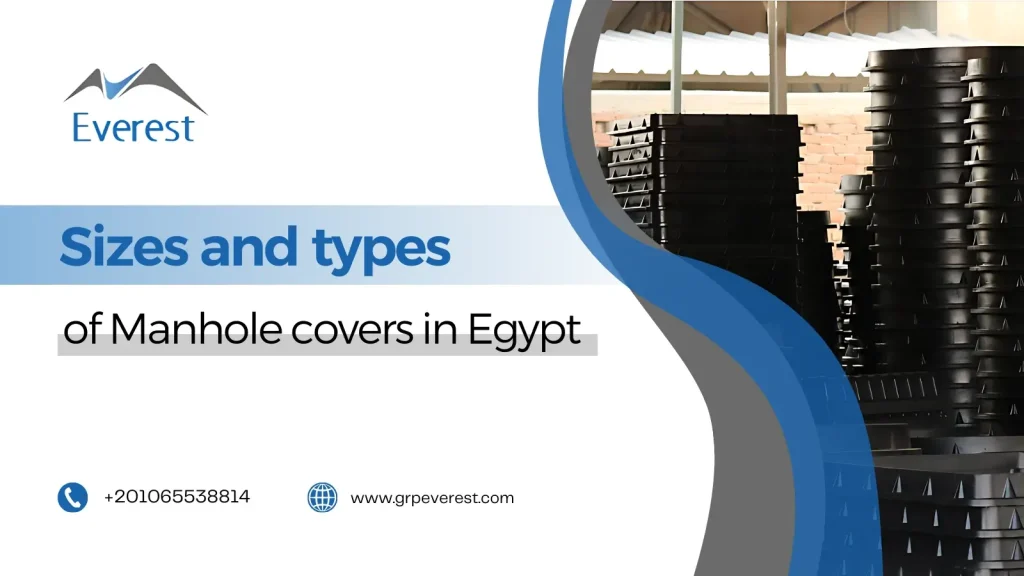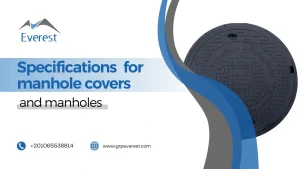Manhole covers are a vital component of Egypt’s sewer systems and infrastructure. Manhole covers cover manholes in networks, making them easily accessible for maintenance and inspection. The sizes and types of manhole covers vary and depend on several factors, including the type of network, expected load, and site conditions. In this article, we will explain all the uses, sizes, and types of manhole covers in Egypt and define the criteria for selecting covers.
1. Available manhole cover sizes
Manhole covers in Egypt are available in various sizes to suit different applications. Some of the most popular sizes are
600 mm diameter cover: Often used in domestic sewage systems. This size is suitable for the inspection and maintenance of small and medium-sized pipes.
800 mm diameter cap: Used in larger sewer systems, where a larger water or drainage flow requires access to these openings.
1000 mm diameter cap: Preferred for use in high-traffic areas or large systems that require greater carrying capacity.
Rectangular size covers: Rectangular covers are used in narrow areas, such as sidewalks and streets, where a long manhole cover is needed.
2. Different types of manhole covers
Manhole covers are divided into several types, based on the materials used and manufacturing methods:
A. Iron covers
Iron covers are one of the most common types of manhole covers in Egypt. They are characterized by their strength and ability to withstand heavy weights, making them ideal for use on main streets. They also provide a high level of security, as they are difficult to break or remove easily.
B. Plastic manhole covers
Plastic manhole covers, such as those made of GRP (glass fiber reinforced resin), are used in applications where lightweight and corrosion resistance is required. They are ideal in coastal or industrial areas where steel is subject to corrosion from moisture or chemicals.
C. Concrete caps
Concrete caps are mainly used in large projects, as they provide a high level of durability. They are usually used in areas that need to support heavy weights, such as parking lots or highways. However, they are heavier and require more effort to install.
D. Composite covers
These covers combine the features of different materials, such as steel, plastic, or concrete. They provide a high level of durability and structural strength, making them suitable for a variety of applications.
3. Shapes of manhole covers
When designing manhole covers, the shape of the cover is taken into account in terms of strength and quality, safety and security standards, and the aesthetic form of the product, 3 shapes are the most commonly used:
Round manhole covers: They are round-shaped covers that are widely used in sewage networks on streets and roads.
Square manhole covers: Square manhole covers are square-shaped covers and are widely used in
Rectangular manhole covers: Rectangular manhole covers are largely used in narrow areas on sidewalks and some streets.
4. Criteria for selecting covers
When choosing a manhole cover, several factors must be considered:
Expected load: The type of cover should match the expected weight it will bear. Steel and concrete covers are suitable for high-traffic areas.
Installation environment: If the site is close to the sea or exposed to chemicals, it may be better to opt for plastic or composite covers.
Ease of installation and maintenance: It is preferable to choose covers that provide easy access to the manhole to minimize maintenance costs.
5. What are the uses of the cover?
Manhole covers are used in a variety of applications:
Sewer systems: Ensure safe flow and allow access to networks for inspection and maintenance.
Streets and roads: Provide security and maintain traffic safety.
Public facilities: Used in public parks and playgrounds to improve the aesthetics of the place.
Industrial facilities: Used in factories where covers require high durability to withstand harsh conditions.
6. Future trends
With increasing infrastructure challenges, Egypt is moving towards the use of new materials and innovative technologies in the manufacture of manhole covers. These advancements include the use of composite fibers, which provide greater lightness and durability. Improved installation methods are also being researched to ensure better efficiency and reduce costs.
Conclusion
Manhole covers are an essential element of Egypt’s infrastructure, playing a vital role in maintaining the integrity and efficiency of sewer networks. By understanding the different types and sizes available, installation and maintenance choices can be optimized, contributing to the development of a safe and sustainable urban environment.




